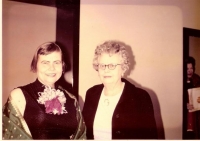News story from TWU campus newspaper (Lasso) about Clark's talk & photo exhibit of poets' portraits
Headline: Alumna displays artwork in library
By Julie Arnold, Managing Editor, with Lasso photos by Tabitha Foret
Note: 2 Photos published with article, are not included here. The caption for Photo 1 read: LaVerne Harrell Clark displays art work at exhibit "Contemporary American Poets"
The caption for Photo 2 read: LaVerne Harrell Clark autographs a book for TWU Faculty member Joyce Palmer
The Blagg-Huey Library hosted TWU Distinguished Alumna LaVerne Harrell Clark Monday night. Clark lectured on her exhibit, "Contemporary American Poets of the 20th Century: Informal Portraits" in the gallery adjacent to the rotunda. She majored in Journalism, but graduated only 3 hours short of getting a second degree in English.
Her current exhibit is a series of portraits capturing the spirit of the place in the settings along with the faces of the poets. Two of her seven books concern contemporary poets and poems. ?It helps to know the inside of the writer,? she said. ?1 don't believe in taking a portrait of a poet 1 don't know. I like to hear at least a lecture or reading, so I can hear them speak a little first."
Cecil Day-Lewis is among the 500 poets and contemporary writers Clark has photographed. Day-Lewis once served as Poet Laureate of England, but today his son, the movie actor, Daniel Day-Lewis, is better known.
(Cont'd p.2)
Clark attributes her success in part to her work at TWU. While in school, she was assigned to conduct an interview for the Lasso with poet/novelist Robert Peter Tristram Coffin, whom she also photographed. Later, after graduation, the picture, actually a bust shot, gave her what would amount to her start in publishing portraits of poets when it appeared in THE AMERICAN SCANDIANVIAN REVIEW magazine.
"We got along famously, and by the time Dr. L.H. Hubbard, then president of TWU, brought him back two years later, during my senior year, I was an editor myself and saw to covering all the stories I could do about him," Clark said.
Another campus lecturer Clark interviewed and photographed was Henry Goddard Leach, editor of THE AMERICAN SCANDINAVIAN REVIEW magazine. He was impressed enough with her and the resulting story with her photographs that he hired her to work in New York City as his "girl Friday" and interview U.N. delegates from Scandinavia for the magazine. While working for him that fall, she began studying short story-writing at Columbia and also published her first magazine article with 3 photographs in the REVIEW, a piece concerning Swedish U.N. delegate, Sven Grafstrom.
Clark also worked for the Fort Worth Press newspaper for some of the year before her marriage, but after it, returned to NYC, later moving to Tucson where she started The Poetry Center at the University of Arizona. "They picked me for the job of being the first director, while we were down in Mexico doing the research for L.D.'s dissertation at Columbia, and without me knowing it, besides," Clark said.*
Still, she says she doesn't consider herself a poet; but a novelist, folklorist and photographer, instead.
"Of course, I do consider myself a prose writer. Also, I started writing fiction with the short story, which to me is more akin to the poem than it is to the novel. It incorporates so much in so little. The photo is another form that compresses everything," Clark said.
*With regard to the matter of Clark's being a fiction writer rather than a poet, who was chosen for the job, Clark has frequently explained to those inquiring that her very dedication to writing both prose and folklore even helped her in being selected for the job. A selection committee spokesperson later told her that they preferred a prose writer who was diplomatic yet dedicated to the cause of poetry to serve as Director, due to their conviction at the time that poets were more likely to associate themselves with this or that school, or clic, whereas they were determined for the Director to work with a Board to bring the best of the poets of the day to the campus, regardless of their identifications or alliances.
She adds that they also liked the idea that she was a folklorist besides and one who possessed strong ethnic ties also.

LaVerne with her mother, Belle Bunte Harrell, to whom she dedicated her novel, KEEPERS OF THE EARTH, following the TWU luncheon (1973) where she was named a Distinguished Alumna. Mrs. Harrell was a great supporter of her daughter's writings, both in folklore and fiction, and she attended any program of hers she could manage. She came from a storytelling family, and she, as a widow, left both the home she and LaVerne's father owned in Smithville, as well as the place that she had inherited from her pioneer ancestors, to LaVerne. The Clarks still owns them, and she has used the now abandoned farmhouse as a setting for KEEPERS OF THE EARTH and several of her stories.


